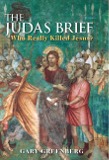Among the many glitches plaguing the production of
The Judas Brief, is that the publication track is out of sync with the publicity track. While the book was officially release last month, the main publicity campaign was only launched today. This could create some difficulties for book sales because book stores only give a book a couple of months to prove itself before they start returning books. Anyway, I thought I would say a few words about "the publicity campaign" for a book that isn't expected to be the top of the pops.
Many want-to-be and first time authors have an
unrealistic expectation of what will happen with the publicity aspects of their book's release. As the author contemplates fame and glory, he or she fantasizes about a major publicity effort on behalf of the book, a few ads i large publications with target audiences, , perhaps in the new York Times, and in biblical circles the author imagines a large ad or two in Biblical Archaeology Review. And, of course, the book should be sent out to a couple of hundred of the most likely review sources and another fifty or a hundred to the leading scholars in the field.
It ain't
happenin'! The publicity budget is minuscule.
Here is how the basic campaign works. A modest print run based on minimum sales expectations is planned. If properly coordinated, a couple of months before your book is released, a couple of dozen galleys, are printed. These are semi-final copies of the book, often with uncorrected errors still to be filtered out. These "uncorrected proofs" are mailed to a handful of major publications whose reviews are highly desired, NY Times, Publishers Weekly, Library Journal,
Booklist and so on. Hopefully at this stage a few well chosen scholars will receive galleys in the hopes of getting them to provide a blurb for the book cover. At this point, zero ads are contemplated.
While awaiting the hoped-for reviews in these few publications, the main publicity
campaign is set up. How much effort is put into it may depend on whether the galleys get reviews. If significant
positive reviews come out, creating a buzz, a more extensive promotion campaign will be planned, depending on the level and quality of the reviews. For the most part, for the 99% plus of books that wont get any reviews, the publishers publicity campaign will consist primarily of a press release mailed out to a selected media list, and some review copies will be sent out to a few selected sources. The publicity budget won't allow for much more than that. The press release will be little more than a book title, black and w
hite picture of the book cover, publisher information, a restatement of the jacket copy, and, if there are any reviews or scholarly endorsements they will be incorporated into the mailing. That's about it. After that goes out, the
publisher will wait to see if anything hits and if sales are generated. You generally have a four-month window to generate sales, and if it doesn't work, the book is dead.
When I did "101 Myths of the Bible," the publisher targeted the radio-television talk shows and religious oriented radio stations. The press kit included a release and proposed questions for the interviewer to ask the author. This was relatively effective. I did a large number of radio interviews (by phone) and many of the interviewers, not really knowledgeable about biblical subjects, used the proposed questions to guide them through the interview. The campaign turned out to be moderately successful and the book had/has a good run. There were several print reviews, too, but not a large number.
For
The Judas Brief, things got off to a rocky start. A handful of galleys went out to the primary review targets but the book had already been late to publication because of several other glitches, and it came out almost immediately after the galleys, in early June, and the publicity
campaign wasn't ready to go. I got an advance copy of the press release, prepared along the lines described above, and a
fairly limited mailing list. I was quite concerned and asked for a meeting with the
publicity department. (Fortunately, I only live a few blocks from the publisher's office.) In advance of the meeting, I rewrote the press release with a
provocative headline ("Historian charges Gospel authors with deliberately misrepresenting role of Jews in the Passion story") and wrote some more dynamic and longer copy than that from the previous press release and the book flap. I also wrote a more publicity-oriented author biography, prepared a sample interview of myself, and listed several interesting facts about the Gospels based on my book. At the meeting I proposed a more
expansive promotional mailing of the press kits and suggested revisions of the mailing list for who would also receive review copies of the book.
Ultimately, they agreed to most of my suggestions. The press kit would include my rewritten press
release, incorporating a color photo of the book cover, and my author interview, biography, and interesting facts. They did some slight touch up of the copy and we were going to go with a mailing a couple of weeks ago. Then we got word that one of the galley-targeted reviewers was going to do something on the book and we decided to hold off a few days to see what they were going to say. If positive, we planned to include it in the press kit. An advance copy of the review came in yesterday, it was short but mostly positive. We added it to the press kit and everything went out today. Hopefully, the changes I worked out will have an impact, but about six weeks of my four months have already been eaten up.


